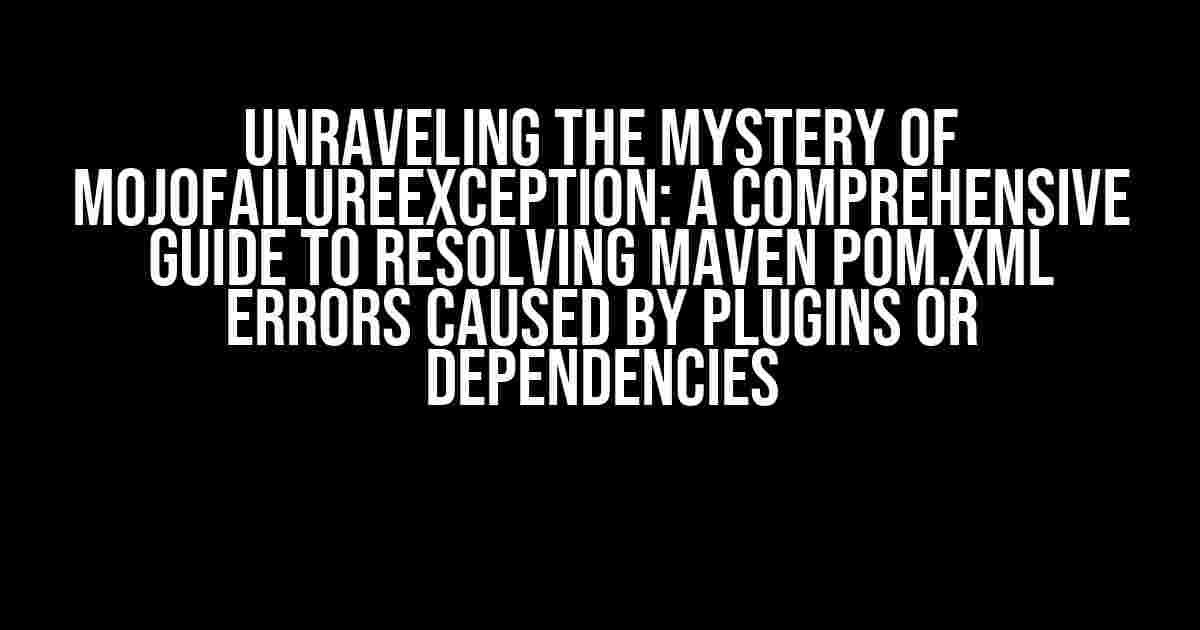Are you tired of encountering the elusive MojoFailureException error in your Maven project’s pom.xml file? Worry not, dear developer! This article is here to guide you through the treacherous waters of plugin and dependency conflicts, ensuring you’re back on track in no time. Buckle up, and let’s dive into the world of Maven troubleshooting!
Understanding the MojoFailureException Error
The MojoFailureException error is a generic Maven error that occurs when a plugin fails to execute its goal. This can be caused by a variety of factors, including:
- Incorrect plugin configuration
- Dependency conflicts or version incompatibilities
- Corrupted plugin or dependency files
- System environment issues
In this article, we’ll focus on resolving MojoFailureException errors caused by plugins or dependencies. By the end of this journey, you’ll be equipped with the knowledge to tackle even the most stubborn Maven errors.
Step 1: Identify the Culprit – Plugin or Dependency?
To begin, we need to determine whether the error is caused by a plugin or a dependency. A plugin is a Maven component that executes a specific task, such as compilation, testing, or deployment. A dependency, on the other hand, is a library required by your project.
Inspect your pom.xml file and look for the plugin or dependency that’s causing the error. You can usually find this information in the error message itself or by analyzing the Maven build output.
Plugin-Related Errors
If the error is caused by a plugin, try the following:
mvn clean package -X– Run this command to enable debug mode and gather more information about the error.- Check the plugin configuration – Review the plugin’s configuration in your pom.xml file. Ensure that all required fields are properly set, and there are no typos or invalid values.
- Update the plugin version – Try updating the plugin version to the latest one available.
- Disable the plugin – Temporarily disable the plugin to see if the error persists. If it doesn’t, you’ve found the culprit!
Dependency-Related Errors
If the error is caused by a dependency, try the following:
mvn dependency:tree– Run this command to generate a dependency tree, helping you visualize the relationships between dependencies.- Check for version conflicts – Review the dependency versions in your pom.xml file. Ensure that there are no version conflicts or incompatibilities.
- Update dependency versions – Try updating the dependency versions to the latest ones available.
- Exclude transitive dependencies – If a dependency is causing issues, try excluding its transitive dependencies using the
<exclusion>tag.
Common MojoFailureException Scenarios and Solutions
Let’s explore some common MojoFailureException scenarios and their solutions:
| Scenario | Solution |
|---|---|
| Plugin incompatibility | Update the plugin version or try a different plugin. |
| Dependency version conflict | Update the dependency version or use a version range. |
| Corrupted plugin or dependency file | Delete the corrupted file and retry the build. |
| System environment issue | Check the system environment variables and adjust accordingly. |
Advanced Troubleshooting Techniques
If the above steps don’t resolve the issue, it’s time to get advanced! :
Enable Maven Debug Mode
Run your Maven build with the -X flag to enable debug mode. This will provide more detailed output, helping you pinpoint the error.
mvn clean package -X
Analyze Maven Logs
Inspect your Maven logs to identify the exact error message and its origin. You can find the logs in the target/surefire-reports directory.
tail -f target/surefire-reports/TEST-*.txt
Use Maven Profiling
Maven profiling helps you identify performance bottlenecks and error-prone areas in your build. Use the following command to enable profiling:
mvn clean package -Pprofile
Conclusion
In this article, we’ve explored the mysteries of MojoFailureException errors in Maven pom.xml files. By following these steps and techniques, you’ll be well-equipped to tackle plugin and dependency conflicts, ensuring your builds are smooth and efficient.
Remember, troubleshooting is an art that requires patience, persistence, and creativity. Don’t be afraid to experiment, and always keep a keen eye on your Maven build output.
Now, go forth and conquer those MojoFailureException errors like a pro!
Frequently Asked Question
Stuck with the MojoFailureException error in your Maven pom.xml? Don’t worry, we’ve got you covered! Here are some frequently asked questions and answers to help you troubleshoot and resolve this pesky error.
What is a MojoFailureException in Maven?
A MojoFailureException is a type of exception that occurs when a Maven plugin fails to execute its mojo (short for “Maven plain Old Java Object”). This can happen due to various reasons such as plugin configuration issues, dependency conflicts, or version incompatibilities.
What are the common causes of MojoFailureException in Maven?
The most common causes of MojoFailureException include incorrect plugin configuration, version conflicts between plugins, missing or outdated dependencies, and corrupted Maven repository. It can also be caused by typos or incorrect syntax in the pom.xml file.
How do I troubleshoot a MojoFailureException in Maven?
To troubleshoot a MojoFailureException, start by checking the Maven logs for more detailed error messages. Then, verify your plugin configuration and dependencies, and make sure they are up-to-date. You can also try cleaning and rebuilding your Maven project or checking for version conflicts between plugins.
Can I ignore the MojoFailureException and continue building my project?
No, it’s not recommended to ignore the MojoFailureException and continue building your project. This exception indicates a serious issue with your project’s build process, and ignoring it can lead to errors or inconsistencies in your project. Instead, take the time to troubleshoot and resolve the issue to ensure a stable and reliable build.
How do I prevent MojoFailureException from occurring in the future?
To prevent MojoFailureException from occurring in the future, make sure to regularly update your plugins and dependencies, and verify your pom.xml file for syntax errors. You should also test your project build regularly to catch any potential issues early on. Additionally, consider using Maven’s built-in features, such as the Maven Enforcer Plugin, to ensure consistency and quality in your project’s build process.

